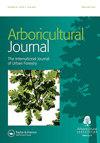诱导或促进温带树木对外来疫霉自然抗性的方法有多有效?系统回顾
Q3 Agricultural and Biological Sciences
引用次数: 1
摘要
温带森林地区一些最突出的外来病原体属于疫霉属。这种病原体是通过酶破坏活的植物细胞来滋养的,可以导致超过150种植物的死亡,包括许多温带森林树木。然而,研究表明,树木的自然抗病性可以通过使用生化化合物的方法直接诱导或促进,包括叶面喷雾、树干注射或树皮施用以及土壤改进剂。本系统综述鉴定并分析了在温带树木诱导对不同疫霉自然抗性的新处理的效果。结果表明,与对照相比,除一项实验外,所有实验的处理均减轻了疫霉感染症状。树干注射的累积疗效最高,合并效应大小为1.85±0.56 (Hedge’s g±95%置信区间)。叶面喷雾剂的效果次之,综合效应值为1.11±0.28。土壤改良剂的累积效果最低,综合效应值为0.61±0.36。本综述支持在苗圃、城市森林、果园和植物园中对树木进行处理;然而,成功与否取决于最佳剂量的应用。本文章由计算机程序翻译,如有差异,请以英文原文为准。
How effective are methods to induce or facilitate the natural resistance of temperate trees to exotic Phytophthora species? A systematic review
ABSTRACT Some of the most prominent exotic pathogens in temperate forest regions belong to the genus Phytophthora. The pathogen, which is nourished by the enzymatic destruction of living plant cells, can cause mortality in >150 plant species including many temperate forest trees. However, studies have demonstrated the natural disease resistance of trees can be directly induced or facilitated using methods to deploy biochemical compounds that include foliar sprays, trunk injection or bark application, and soil amendments. This systematic review identified and analysed the efficacy of novel treatments to induce a natural resistance against different Phytophthora species in temperate trees. Results showed that treatments reduced Phytophthora infection symptoms compared to controls in all but one of the experiments reviewed. Trunk injections demonstrated the highest cumulative efficacy with a pooled effect size of 1.85 ± 0.56 (Hedge’s g ± 95% confidence interval). Foliar sprays had the second highest efficacy, with a pooled effect size of 1.11 ± 0.28. Finally, soil amendments had the lowest cumulative efficacy, with a pooled effect size of 0.61 ± 0.36. This review supports the use of treatments on trees in nurseries, urban forests, orchards, and arboreta; however, success is dependent upon the application of optimal doses.
求助全文
通过发布文献求助,成功后即可免费获取论文全文。
去求助
来源期刊

Arboricultural Journal
Agricultural and Biological Sciences-Agronomy and Crop Science
CiteScore
2.40
自引率
0.00%
发文量
28
期刊介绍:
The Arboricultural Journal is published and issued free to members* of the Arboricultural Association. It contains valuable technical, research and scientific information about all aspects of arboriculture.
 求助内容:
求助内容: 应助结果提醒方式:
应助结果提醒方式:


